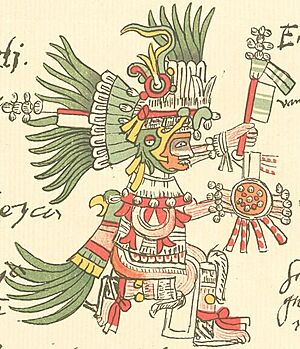Mexica facts for kids

Music and dance during a One Flower ceremony, from the Florentine Codex
|
|
| Regions with significant populations | |
|---|---|
| Languages | |
| Classical Nahuatl | |
| Related ethnic groups | |
| Other Nahua peoples |
The Mexica (pronounced "Meh-SHEE-kah") were a group of people who spoke the Nahuatl language. They lived in the Valley of Mexico and were the main rulers of the powerful Aztec Empire. In 1325, the Mexica built their capital city, Mexico Tenochtitlan. It was on an island in Lake Texcoco. A group of Mexica separated and started their own city called Mexico-Tlatelolco. This city had its own leaders. In 1521, the Mexica were defeated by Spanish explorers and other local groups. These groups included the Tlaxcaltecs, and they were all led by Hernán Cortés.
Contents
What Does the Name Mexica Mean?
The name Mexica is where the name Mexico comes from. Mēxihko originally meant the connected towns in the valley where Mexico City is today. This group was also known as the Culhua-Mexica. This name showed their connection to the neighboring Culhua people. The Culhua were descendants of the respected Toltecs. The Toltecs lived in their capital city of Tula from the 10th to 12th centuries.
The Mexica people of Tenochtitlan were also called the "Tenochca". This name came from their city-state, Tenochtitlan. It also came from their founding leader, Tenoch.
The name Aztec was created by Alexander von Humboldt. He combined Astlan ("place of the heron"), which was their mythical homeland, and tek(atl) "people of". Today, "Aztec" often refers only to the Mexica people of Tenochtitlan. This term does not include the Mexica from Tlatelolco or the Kōlwah. However, the word Aztec is often used more widely. It can refer to all the Nahuatl-speaking peoples from the Valley of Mexico and nearby areas.
The History of the Mexica People

Around 1200 CE, after the Toltec civilization declined, many Nahua-speaking groups moved into the Valley of Mexico. They might have all come from a place called Aztlán, but its exact location is unknown. The Mexica were the last group to arrive in this valley. There, they found what was left of the Toltec empire.
According to their legends, the Mexica were looking for a special sign from their main god, Huitzilopochtli. They were told to find "an eagle with a snake in its beak, sitting on a prickly pear cactus." They were to build their city in that spot. Eventually, they reached Lake Texcoco. On an island in the lake, they finally saw the eagle and the cactus. They settled there and named their new home Tenochtitlan. This name means "Among the Stone-Prickly Pear Cactus Fruit."
Tenochtitlan was founded in 1325. However, some researchers believe it was founded in 1345. A Spanish explorer named Bernal Díaz del Castillo described the city as a grand and well-organized place. But the story of its growth from the muddy lake beds was one of constant struggle. There were many rivalries, conflicts, and hardships.
Founding of Tlatelolco
A group of Mexica separated from the main community. In 1337, they built another city on an island north of Tenochtitlan. They called their new home Tlatelolco, meaning "Place of the Spherical Earth Mound." The Tlatelolca people became constant rivals to Tenochtitlan in the Valley of Mexico.
After the Aztec Triple Alliance grew strong, the Tenochca Mexica became the most powerful. They lived in Tenochtitlan and held power over their two allied city-states, Texcoco and Tlacopan. Just a few years after Tenochtitlan was founded, the Mexica controlled Central Mexico. They remained powerful until they were defeated by the Spanish and their local allies in 1519.
Mexica Temples and Gods
Once they settled in Tenochtitlan, the Mexica built large temples for different purposes. The Templo Mayor (Main Temple) and nearby buildings were full of Aztec symbols. These symbols connected rain and fertility with war, sacrifice, and empire building. They believed it was their sacred duty to keep the sun and the cosmic order going.
The Templo Mayor was a place for large-scale sacrifices of enemy warriors. These sacrifices served both political and religious goals. It was a double pyramid-temple. One side was for Tlaloc, the ancient Central Mexican rain god. The other side was for Huitzilopochtli, the Mexica's tribal god. As the most powerful god in Mexico, Huitzilopochtli was linked to the sun. Over time, the Mexica made Huitzilopochtli more important than Tezcatlipoca, another god. They changed their myths and made Huitzilopochtli politically superior.
The Mexica of Tenochtitlan were conquered by the Spanish explorers. This happened under Fernando (Hernán) Cortés in 1521. After the Spanish conquest of Mexico, the area expanded. It was then ruled from the former Aztec capital as New Spain.
The Language of the Mexica
Like many people around them, the Mexica spoke Nahuatl. As the Aztec Empire grew, Nahuatl became a common language in other areas. The form of Nahuatl used in the 16th century was written using the Latin alphabet. This alphabet was brought by the Spanish. This written form became known as Classical Nahuatl. Today, more than 1.5 million people still speak Nahuatl, mostly in Mexico.
it:Mexica
See also
 In Spanish: Historia mexica para niños
In Spanish: Historia mexica para niños

